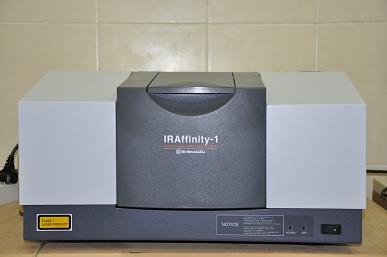I.R. 2
تاريخ النشر : 0000-00-00 00:00:00
عدد المشاهدات : 146

تاريخ النشر : 0000-00-00 00:00:00
عدد المشاهدات : 146

I.R.
Infrared spectroscopy (IR spectroscopy) is the spectroscopy that deals with the infrared region of the electromagnetic spectrum, that is light with a longer
wavelength and lower frequency than visible light. It covers a range of techniques, mostly based on absorption spectroscopy. As with all spectroscopic
techniques, it can be used to identify and study chemicals. For a given sample which may be solid, liquid, or gaseous, the method or technique of infrared
spectroscopy uses an instrument called an infrared spectrometer (or spectrophotometer) to produce an infrared spectrum. A basic IR spectrum is essentially
a graph of infrared light absorbance (or transmittance) on the vertical axis vs. frequency or wavelength on the horizontal axis. Typical units of frequency
used in IR spectra are reciprocal centimeters (sometimes called wave numbers), abbreviated as cm−1. Units of IR wavelength are commonly given in microns,
abbreviated as μm, which are related to wave numbers in a reciprocal way. The infrared portion of the electromagnetic spectrum is usually divided into three
regions; the near-, mid- and far- infrared, named for their relation to the visible spectrum. The higher-energy near-IR, approximately 14000–4000 cm−1 (0.8–
2.5 μm wavelength) can excite overtone or harmonic vibrations. The mid-infrared, approximately 4000–400 cm−1 (2.5–25 μm) may be used to study the
fundamental vibrations and associated rotational-vibrational structure. The far-infrared, approximately 400–10 cm−1 (25–1000 μm), lying adjacent to the
microwave region, has low energy and may be used for rotational spectroscopy. The names and classifications of these subregions are conventions, and are
only loosely based on the relative molecular or electromagnetic properties.
This program makes pass/fail judgments about samples in accordance with the tests specified in the Pharmacopoeia. In addition to identification tests for
pharmaceutical products, this program can be used for incoming inspections and pre-shipment inspections. Also important for detection of newly synthesized
compound and impurities in chemistry.
The infrared spectrum of a sample is recorded by passing a beam of infrared light through the sample. When the frequency of the IR is the same as the
vibrational frequency of a bond, absorption occurs. Examination of the transmitted light reveals how much energy was absorbed at each frequency (or
wavelength). This can be achieved by scanning the wavelength range using a monochromator. Alternatively, the whole wavelength range is measured at once
using a Fourier transform instrument and then a transmittance or absorbance spectrum is generated using a dedicated procedure. Analysis of the position,
shape and intensity of peaks in this spectrum reveals details about the molecular structure of the sample.This technique works almost exclusively on samples
with covalent bonds. Simple spectra are obtained from samples with few IR active bonds and high levels of purity. More complex molecular structures lead to
more absorption bands and more complex spectra. The technique has been used for the characterization of very complex mixtures.
يستخدم للكشف او تحديد الشكل الكيميائي للنماذج والعينات وفقا للاختبارات المنصوص عليها في دستور الأدوية. بالإضافة إلى اختبارات تحديد للمنتجات الصيدلانية